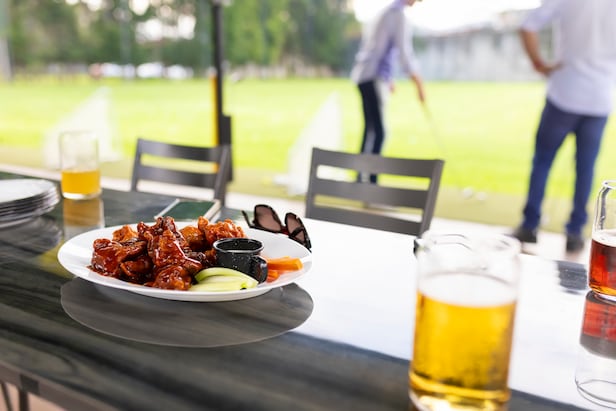Phil Mickelson: Hit Bombs Well Into Your 50s – Australian Golf Digest

- by Admin
- August 28, 2024

Copy my speed training and you, too, can leave your much younger playing partners shaking their heads.
There are a lot of things golfers can do to maintain their speed. As we get older, however, this can be more difficult to achieve, but there are a few things that I’ve learned in my 50s that you can utilise yourself to avoid losing speed off the tee.
First thing’s first: before we get into my speed training techniques, you have to have an off-course regime in place so that you don’t get hurt. What happens is, when we start getting into speed training, the tendency is to swing so fast that we overextend the facet joints in our back. This is bad news and something you must avoid. So, you always have to start with a week or two, at least, of physio ball training – exercises that get your back and your core strong so that it can support what we’re about to do. You don’t want to just jump into this.
Once you’re in some sort of shape, read on and let’s go hit some bombs!
1. Swing heavy to build muscle
Every day I’ll hit some balls with a very heavy club. That orange driver you see [photo 1] boasts a 310-gram head. The reason I have this is, after each round I like to hit five balls as hard as I can with this club because I’m already fatigued and worn down and this helps build muscle. The key to this is swinging slow. This club is not training me to swing fast – it’s purely building the muscles so that I can swing fast. The excess weight in the clubhead also prevents me from getting too fast at the top. By doing so, I’m creating more speed down low at impact. Being a heavier club, I’ll swing it and try to hit it and I have to wait. If I don’t do that, I’ll hang it. As a result, this helps me square everything up.

2. Go light for more speed
I always carry speed sticks wherever I go. I find these easy to travel with because I only have to carry one and I can just interchange the weights [photo 2]. I like to knock it down and make it a little bit lighter. What you see in the picture is lighter than my normal driver. By using this adjustable weight device, I can train myself to produce more speed (by swinging faster than normal). But the key here is that you practise swinging both ways (in both directions). By that I mean the decelerating muscles in my swing are the acceleratory muscles going the other way. So, I want to make sure that I swing fast going both ways and I’ll usually do five swings on both sides. I’ll try to go as fast as I can the other way, just to get properly loosened up. This is training myself to swing it faster. Remember, you’re looking for about a 12 to 15-percent decrease in weight from the driver you use in order to create the ideal speed gains you need to swing it faster. If I want to swing the clubhead 120 miles per hour, I need to be able to swing my speed stick at 125-126mph. By doing that, I’m training my neural system to swing it faster.
Another quick drill I’ve learned from guys like Padraig Harrington and older guys that really hit it hard, is twice a week, after I’ve played a round, I’ll go hit 25 drives as hard as I can. I’ll swing all out. I’m not worrying about where it goes, I’m just getting my nervous system to fire faster.

3. Want some extra kick? Try the front-leg push
So, there are some power moves that TPI (Titleist Performance Institute), who are at the forefront of speed training, talk about and I’ll focus on one of them that’s really helped me. They often talk about, at the top of the swing, how you can bend your elbow to get more leverage. That’s a tough one for me because of the timing. They also talk about opening the rear foot so you get a better turn. I don’t really need to do that because I have pretty good hip mobility. That move would be accommodating a particular body style that doesn’t quite turn as well. The one move I really like to focus on, however, is the front-leg push because it’s so important for creating speed. If I’m pushing off my front leg as I take the club back, when I push up, my hands are always going to come down – I can’t keep them up. If you watch the top long drivers on tour – guys like Bryson DeChambeau and Bubba Watson – it’s proof that your knee is meant to bend during the swing. There’s an amenable rotation but not a lot. Your knee is not meant to support the type of violent rotation in the golf swing. It’s therefore important that this gives a little bit, that your toe be able to give. As we push, you actually want your front foot to come off the ground. It relieves the pressure and let’s your toe open up [photo 3]. We’ve learned the hard way over the years through a number of players who have not done that, players who swing violently, and consequently they have had a bunch of knee surgeries because it’s just not the way, physiologically, your knee is designed to move. So, as I push, one of the power sources is to push up with your front leg. It’s almost up and back. I don’t want to be going forward because then it’s like throwing a baseball while moving forward. You want to create that whip so your body’s almost going back as you’re throwing. I want to have my body work back, or at least feel that way. The results of this movement are plain to see: when I put on a regular, stock swing with a planted front foot, I generate around 167mph ball speed. When I speed it up and use more leg and push back in the way I have explained, I’m accelerating through the shot more, my front leg opens up and my toes come back. It relieves the pressure and I’m hitting 176mph ball speed. If I get to the gym and I start doing exercises that strengthen that leg, that will generate even more explosiveness, and my speed continues to go up even more.
Final tip: Be consistent with your training
I’m 54, but I’m doing stuff every day. I always start and end the day with some physio ball work to make sure my back is healthy. There are three areas that I’m concerned about as a golfer: knees, lower back and shoulders. As a result, I’m constantly stretching. I’m constantly activating those muscles to strengthen them in order to prevent injury. I’ll carry a stretching band with me in my bag. I’ll put it on the golf cart and I’ll do shoulder work before I play. I make sure I do particular shoulder exercises because I want to protect my rotator cuffs, a common injury in golf as we age. I also want to make sure my lower back doesn’t get tight. For me, that always starts in the hamstrings and then goes up into the hips before working its way into the lower back. So, I’m constantly doing stretches where I’ll try to relieve the pressure on my back as I go down and try to create certain movements. My tip: strengthen the flexibility in your hamstrings!
One of the things that gets the small muscles in my back, which is very hard to do, is a deep squat where I push out on my leg. I’ll try to keep my feet square and I do this like a dozen times a day. I do a deep squat into my heels so that my heels stay on the ground, and then I push out. As I push out and let myself sag down, the muscles around the spine start to relax. That’s one of the things I do to keep my back in better shape that I’m sure can work for you, too.
The Latest News
-
January 9, 2025Australian captain Pat Cummins in doubt for Champions Trophy as ankle injury revealed
-
January 9, 2025Alex de Minaur faces prickly path as Nick Kyrgios lands ‘kind’ Australian Open draw
-
January 9, 2025Missing Australian hiker found after surviving two weeks on muesli bars and berries
-
January 9, 2025De Minaur handed tricky Aus Open draw, Jones to face former Wimbledon champ
-
January 9, 2025Captain Cummins in doubt for Champions Trophy | cricket.com.au





